PS-SPS Users Meeting for Week 39 held on September 26th 2024
Coordinator for this week: E.Barbara Holzer
SPS proton beam will stop on Thursday 31th October in the morning. The last users have one additional night of beam!
- Updated user schedule v3.3.0 on September 11th
- Submission period for beam requests for 2025 is expected to open beginning of next week.
- DRAFT Injector schedule for 2025 is available here: https://edms.cern.ch/document/3057281/latest
- AD/ELENA is installing a new beam line for antiproton / H- test beam called TELEMAX. Call for beam requests for the TELEMAX beamline for 2024 and 2025 is expected to go out soon.
News from the PS & SPS Physics Coordinator
E.B. Holzer, M.R. Jäkel
Proton Run 2024
- AD/ELENA Physics Stop Monday 02.12.2024
- SPS NA Physics Stop protons Thursday 31.10.2024
- PS EA Physics Stop protons Wednesday 27.11.2024
Ion Run 2024
- SPS NA Physics Start 4.11.2024
Stop Pb ions Monday 2.12.2024 (6h)
- NA : Week 45-47 high energy
- NA : Week 48 low energy (no LHC running)
- PS EA Physics Start 6.11.2024 (tbd)
Stop Pb ions Monday 2.12.2024 (6h)
Reminder: Beam time exceeding the limits of 2 weeks PS beam time and 1 week SPS beam time per year need the approval of one of these CERN committees: SPSC, LHCC, DRDC, INTC, RB or IEFC. Consider joining a DRD collaboration, if you require more beam time.
Target intensities:
See here or via ASM (accessible from within the CERN network).
News from the Facilities Operations Meeting (FOM) (M.R. Jäkel)
Upcoming SPS MDs next weeks :
https://be-dep-ea.web.cern.ch/content/md-planning-north-area
Dedicated SPS MDs - if not anounced differently - are taking place from 8:00 to 18:00
- Week 39: Crystal shadowing + TAX and wobbling (extraction to targets) + hysteresis compensation
- no beam to NA 8:00 to 20:00
- extended by two hours to compensate for lost MD time during the last weeks
- access to ECN3 could be possible during the last 2 hours of the MD (from 18:00 onwards) and/or during access required for MD (get in touch with Dipanwita)
- Week 40: Wednesday dedicated SPS Pb commissioning (no MD, no beam to NA)
- Week 41:
- Wednesday dedicated SPS MD: Spill studies + octupole folding (extraction needed to primary targets only for half day)
- Thursday dedicated SPS Pb commissioning
- Week 42: Wednesday dedicated SPS Pb commissioning
- Week 43: Wednesday dedicated SPS Pb commissioning
- Week 44: Tuesday (!) and Wednesday dedicated SPS Pb commissioning
- Proton beam stops on Thursday (!) morning
PS Machine Report (E.H.Maclean)
Very good availability (98.7%)
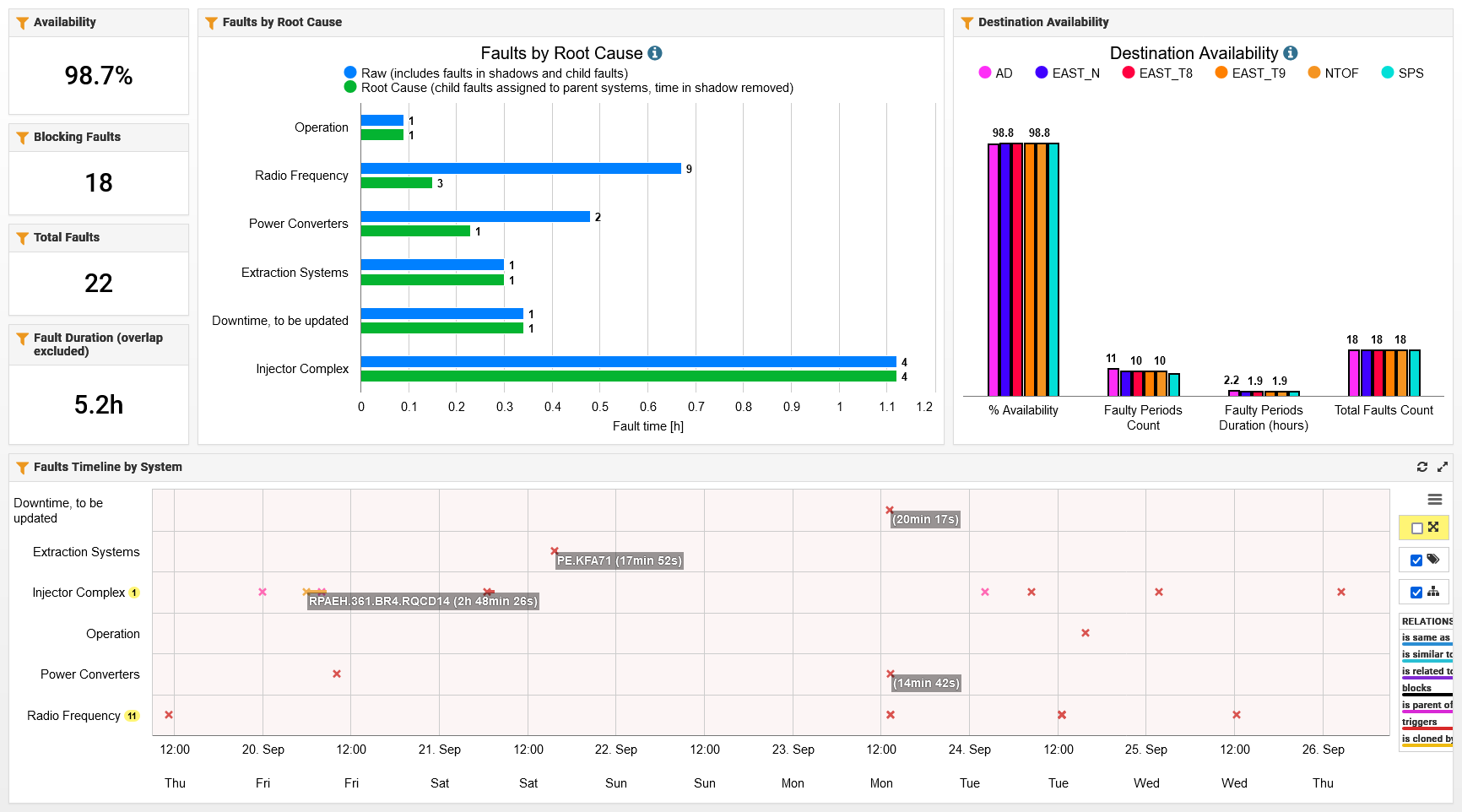
- Intermittent problems with KFA71 extraction kickers pulsing badly during last week leading to dropped shots (similar problem reported last week). Mitigated for now by removing offending modules, but problem still not understood
- Problems with wirescanner measurements since last week (large annomolous spikes appearing in profile data every few shots) affecting reliability of emittance measurements. Investigations ongoing.
- At FOM on Tuesday there was some discussion of PS/PSB access in shaddow of SPS intervention - in practice decided time too short to make productive intervention so no access performed in PS or PSB.
Main activities:
- settup of I-EAST beams continuing. 1GeV beam ready and optics optimized. 500MeV beam significantly advanced, big improvement in transmission seen yesterday - to be confirmed this afternoon. Work also continuing on tests of very low energy ION beam (273MeV).
- Optimization of LHC-type beams - 12b BCMS switched from 3-period to 2-period cycle, to free up space in supercycle
- Settup of dedicated AD beams, for MD yesterday (tests of optimized AD cycle to improve emittance, see if translates to beneficial impact at AD. Study ongoing.)
SPS Machine Report (A. Spierer)
- Overall availability: 93%, NA: 95%
- This week (39):
- Short parallel MDs and dedicated on Wednesday, LHC MDs preparation on Thursday and LHC MDs from Thursday night to Monday
- Next week (40):
- Standard MD week, dedicated Ion commisionning on Wedneday
- Main events/issues
- LHC back on Wednesday night (down since the 23rd)
- Periods of degraded beam caused by 50 Hz, mostly when the supercycle changes
- Experts are closely following
- Issue with a Power Converter prevented extraction to NA Wednesday 21h (QNLD.2105.M) required piquet intervention
- Intervention on RF cavity 3 power on Monday for 1h15
- Piquet intervention on cavity 5 power on Friday nigh for 1h45
Safety (A. Schouten)
- Reminder for ISIEC requests and PPE usage.
n_ToF (M.Bacak, P.M.Milazzo)
Smooth data taking.
End of the measurement dedicated to 24Mg(n, n’) and 16O(n, n’) with different LaBr3 detectors.
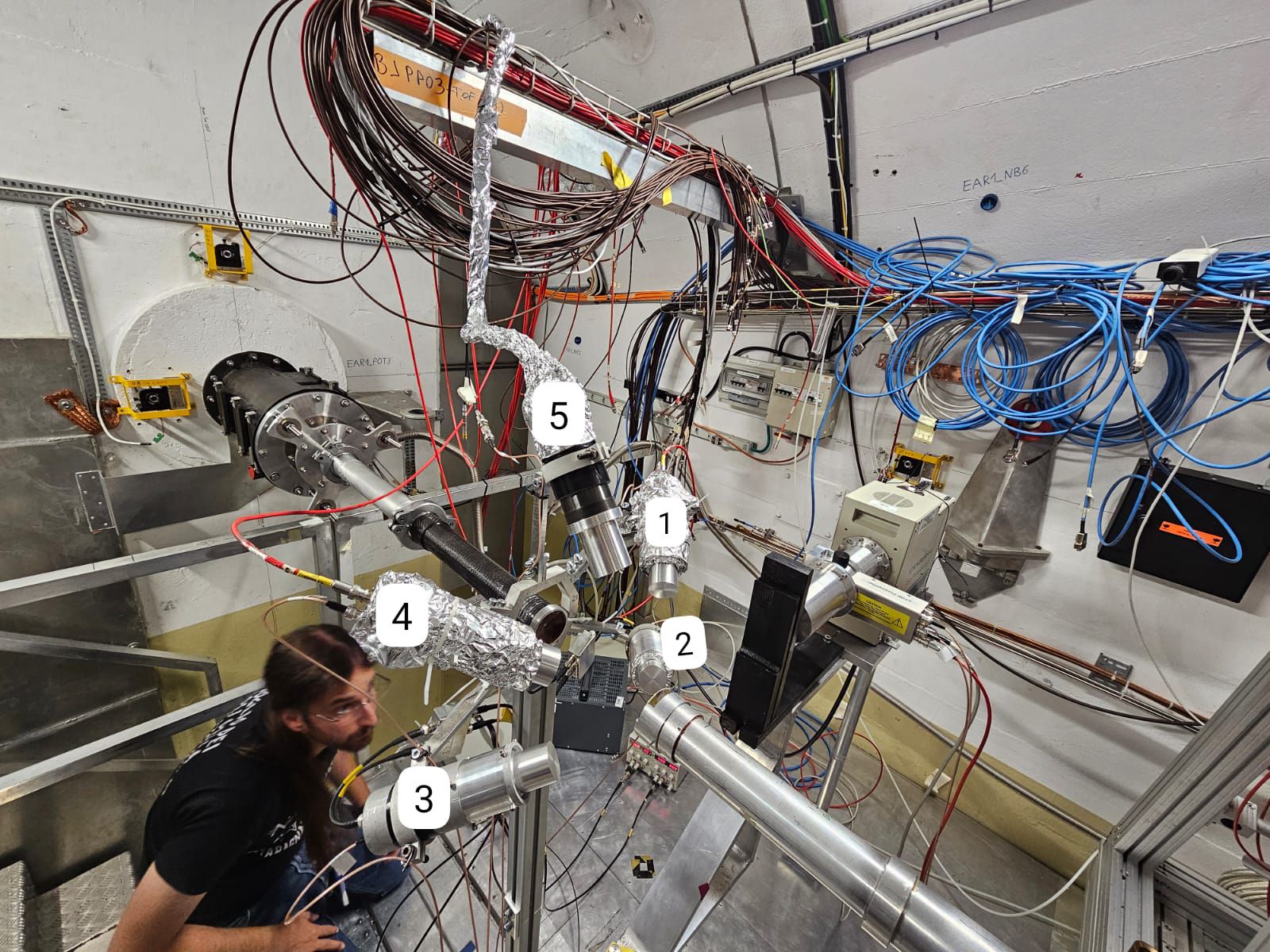
Installation in EAR1 of telescope ΔE-E detectors and of a low mass fission chamber to study Double-Differential Cross Section (DDX) of Neutron-Induced Charged-Particle Emission from a Carbon sample
Data taking on:
- EAR1: 12C(n, lcp) measurement
- EAR2: 40K(n, p), 40K(n, α) measurements
- NEAR: activation measurements
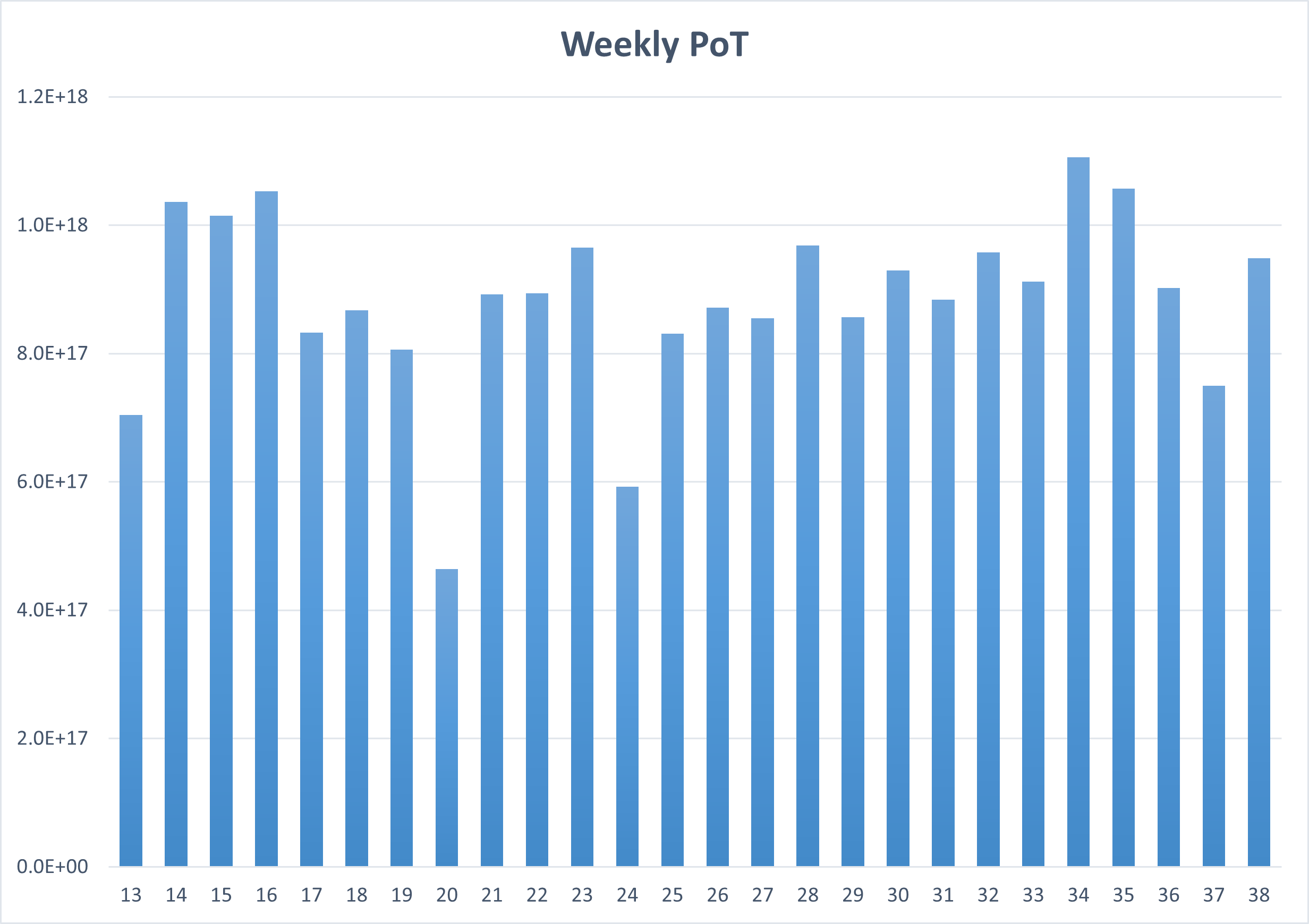
Protons received
East Area Beam Status (J. Bernhard)
On call phone number: 67500
General: Observation that too many users do not have helmets and safety shoes.
T09: Good operation.
T10: Good operation.
T11: Good operation.
East Area Users Tour de Table
T8 Main: IRRAD/CHARM (S.Fiore, D. Bozzato)
last week devoted to RP activities (see below)
Yesterday in IRRAD we installed a new ATLAS ITk experiment while the EP-ESE and other long-term experiments were restarted after the RP week. ALICE FOCAL experiment executed on Wed. afternoon using the same low intensity beam (~1E10 pps) developed for the RP Week. In CHARM we installed setups by BE-CEM and SY-BI.
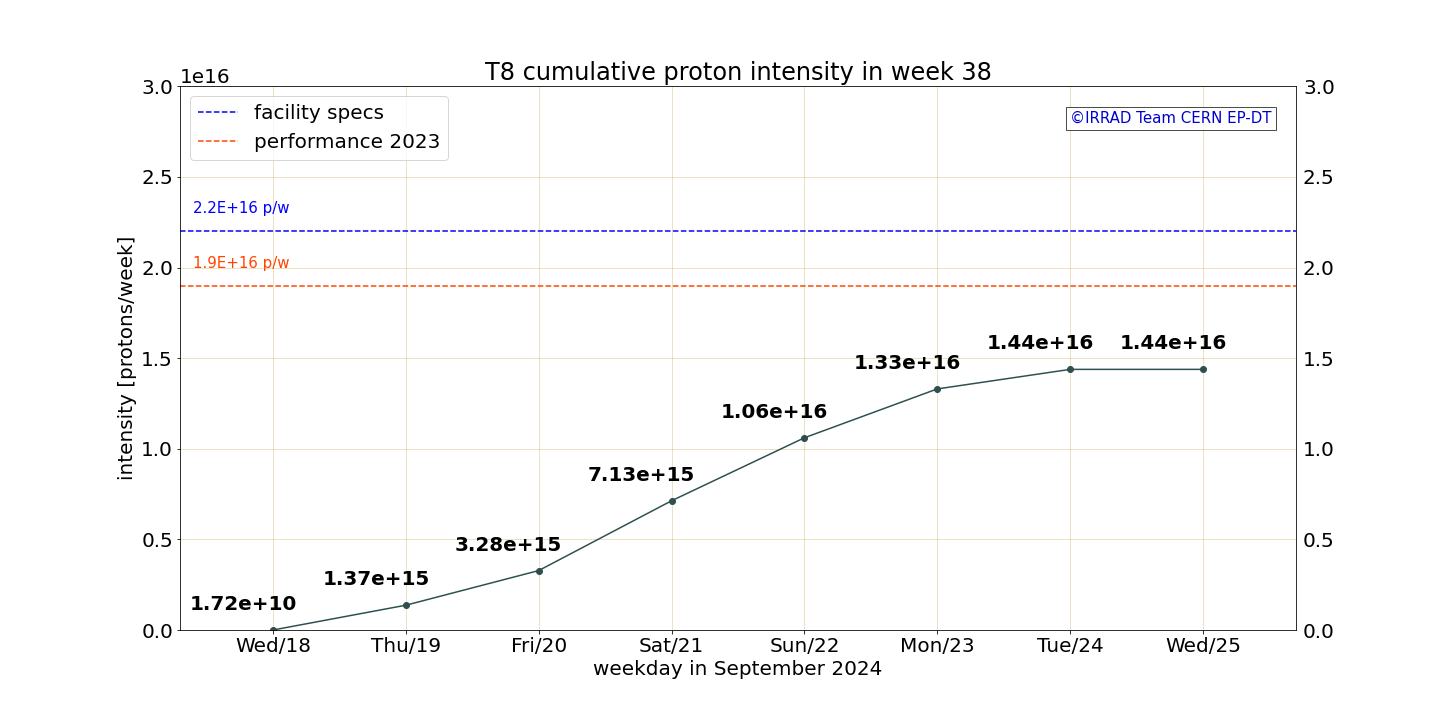
- The RP week (18/09-24/09) at the CERN Shielding Benchmark Facility (CSBF) was successfully concluded on 24/09 and saw the participation of collaborating physicists from KEK.
- Several different experiments were performed:
- characterization of passive neutron dosimeters exposed directly to the secondary field in the target room, and behind thick shields;
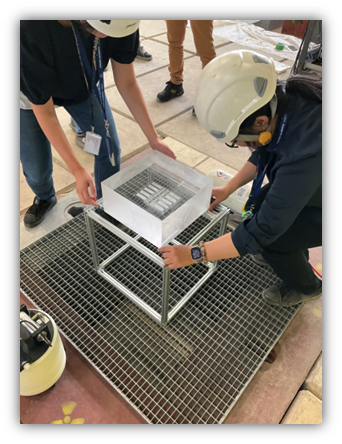
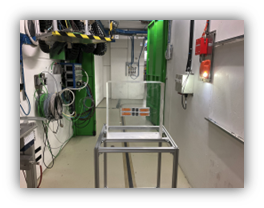
- measurement of high-energy neutron spectra with an assembly of CsI scintillators;
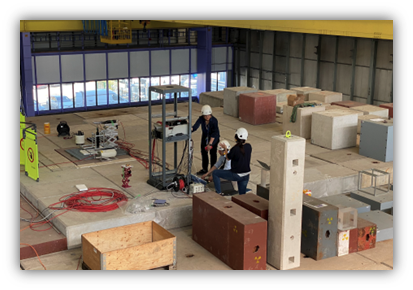
- test of the neutron modules for CERN operational dosimeters (DMCs) in high-energy neutron fields;
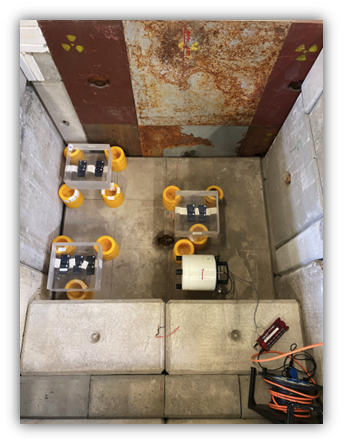
- measurements of the neutron attenuation length in special shielding materials (hematite and barite concretes);
- activation experiments for clearance studies of the LHC electrical cables and residual dose rate benchmarks;
- No particular issue encountered, very good beam conditions for the whole week:
-
T8 mainly operated at 60E10 p/spill but lower and higher nominal intensities also used: 20E10, 30E10, 40E10, 50E10, 70E10, and 80e10 p/spill.
-

-
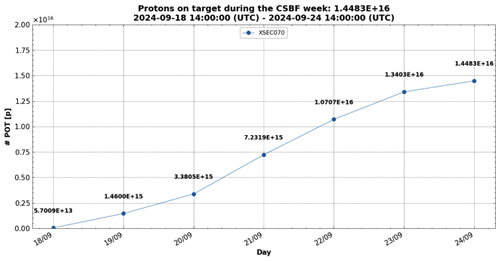
-
Low intensity beams (EAST_LI_24) were also used with intensities of 1E10 and 3E10 p/spill.
- We would like to acknowledge BE-OP-PS, BE-EA, EN-HE, the IRRAD and CHARM operation team, HSE-RP-CS, HSE-RP-IL, and the HSE-RP management for the excellent support and efforts that made this week possible.
T9 Main: HIKE SAC & NanoCal (Matthew Moulson)
Yesterday, we ended the main series of measurements with the Crilin prototype for HIKE SAC at 08:00
We are currently doing one additional measurement on time resolution with/without crystal alignment, using a single crystal. We expect this to end by 14:00 today.
The NanoCal prototype is being assembled in the T09 control room and will be installed this afternoon.
All of the rest of our setup is the same, so the switchover will be quite quick.
We are using the same beam files, etc. for NanoCal as for HIKE SAC.
We will give a summary of measurements done at next meeting.
T9 Incoming Main: STRAW TRACKER (Week 40) (Temur Enik, Katerina Kuznetsova)
requirements (we are in contact to Dipanwita and Aboubakr):
- low momenta hadrons (as low as possible)
- low pressure Cherenkov, analogue output
- additional muon veto (concrete block + scint)
- desy table
setups:
- AZALEA telescope
- straw prototype with ASD (sMDT team) or PA+SAMPIC readouts
safety visit (will request asap) for Wednesday 16h00
gas (will contact gas team asap):
- Ar/CO2 (70/30) and Ar/CO2 (93/7)
T10 Outgoing Main: BL4S (S. Zoechling)
Two weeks of successful beam time ended yesterday with both of the winning teams at CERN giving also their final presentations and first results of their measurements yesterday afternoon.
Link to presentation by Team Mavericks from Estonia:
Google Docs Link
Highlights:
- Performed lots of measurements at various muon beam momenta to investigate the observed changes in signal amplitude of their muon detector during their stratospheric baloon flights.
- Found that the effect that the students had observed does not correlate to the amount of deposited energy but is probably caused by influcences of the temperature gradient between mean-sea-level and about 40 km altitude. Thank you to EP TH Safety for checking and approving the changs to the setup to investigate this on rather short notice, much appreciated!
- Took also a lot of data that, with the help of Maarten, sheds some light on the muon energy spectrum and the purity of muon beams in T10. The data will be further analysed and should hopefully benefit other users of the East area as well.
Link to presentation by Team Sakura Particles from Japan:
Microsoft OneDrive Link
Highlights:
- Took data with beamspot on each of the 5x5 scintillator matrix
- Preliminary analysis of their red pitaya data without trigger on FS0&1 that will define the beam spot
- Tested different trigger settings to synchronize the Sakura particles DAQ system to the BL4S setup. The students will be very busy analysing the data gathered during especially the last two nights for quite some time. The first results look very promising.
Thank you so much to everyone involved in BL4S (BE-EA, Beam Instrumentation, Infastructure Services, safety, and so many more)!! We highly appreciate all your time and efforts and we wouldn’t be able to run this without all the precious support we receive!!
Thank you also on behalf of the students which you can see in the pic below:
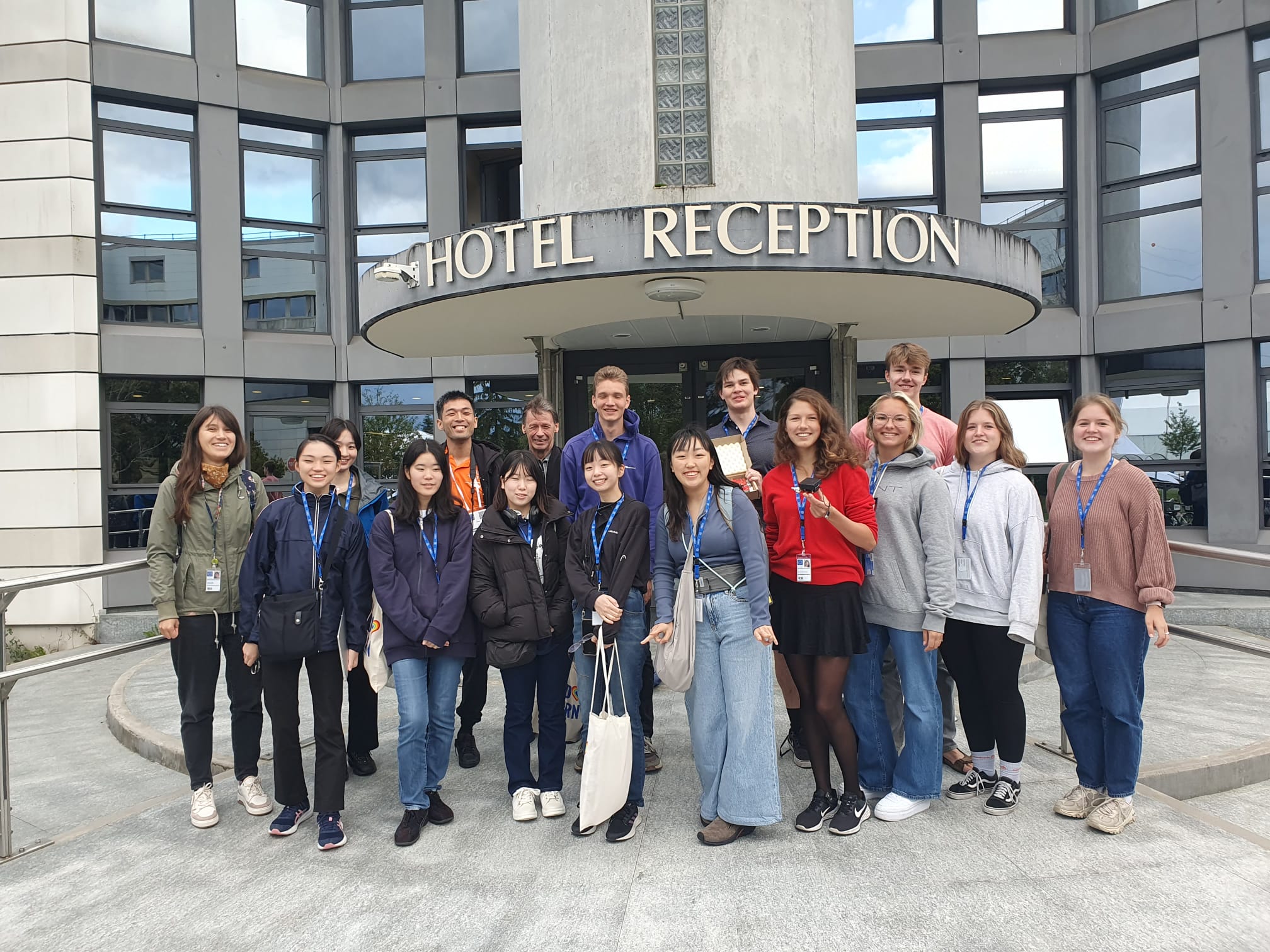
T10 Main: ALICE RICH (M. Nicola Mazziotta)
Set-up completed and we have closed the area around midnight on Sep 24. We are finalizing the layout and opmizing DAQ systems. Today, we still plan to have long access (maybe in free mode)
T10 Parallel: RE7 GAMMA MEV (M. Nicola Mazziotta)
Set-up completed and we have closed the area around midnight on Sep 24. We are finalizing the layout and opmizing DAQ systems. Today, we still plan to have long access (maybe in free mode)
T11 Main: CLOUD (Eva Sommer)
CLOUD campaign is going well. No problems so far.
Incoming AWAKE (Week 40) (M. Bergamaschi)
On Monday 30th of September 5th awake run starts.
Starting physics program
North Area Beam Status (J. Bernhard)
On call phone number: 67500
Target sharing, also in ASM (accessible from within the CERN network)
| T2 |
T4 |
T10 |
T6 |
Date |
Week |
| 30 |
56 |
21 |
150 |
11.09. |
37 |
| 30 |
56 |
21 |
30 |
04.10. |
40 |
| 30 |
56 (45 tbd) |
21 |
150 |
09.10. |
41 |
H2: Good operation.
H4: Good operation.
H6: Good operation.
H8: Good operation.
M2: Electron and muon beams checked. Issue with one jaw of Scraper 752 having fluctuating readings. It was set remotely last week be BE-CEM piquet and on 25th Sep an access was done to confirm the position of the jaw. The potentiometer to be exchanged next Wednesday.
P42/K12: Good operation besides 7h experiment downtime due to double start of spill signal. Steering check on T10 done on Monday. Congratulations to NA62 for reaching 5σ5σ!
For next week for H6/H8 we will change to the negative setup in T4 but due to availabilities this will be done on Thursday 3rd in the afternoon. H6/H8 will have positive charge until then.
For information:

North Area Users Tour de Table
P42-K12:
NA62 (M. Raggi)
Smooth operation during this week. Just an accident with multiple EOB signal received on Thrusday 19th. Traced back to start at 8.30 AM. Required 7h to figure out that the double EOB was coming from accelerator side. First iteration with CCC failed, solved thanks to Nicos.
There is some instability in the 50 Hz component, primarily but not exclusively near the transition of SPS cycles.
M2:
Main: MUONE (Carlo Ferrari)
- We had problems with two tracker modules (not responding and then noisy - solved)
- DAQ is not fully functional yet (data arrives to Serenity board but not on disk): installed new Serenity with two FPGAs (the version that is planned to be used in the long run of 2025)
- Synchronization of tracker and calorimeter data is also still in progress.
So the physics program has not started yet.
We plan to start the program by next weekend
H2:
Outgoing Main: CMS HGCAL (A. Steen, sorry, I may not be able to connect to the meeting)
- 2 weeks of beam test, testing silicon modules and SiPM-on-tile modules
- Detectors were installed in M1 magnet and operated with 3T field
- Acquired data with electron, muon and pion beam
- We operated our detector in several ways, and we learned a lot about our system
- Beam spot from 200 GeV electron showers with/without the magnetic field:
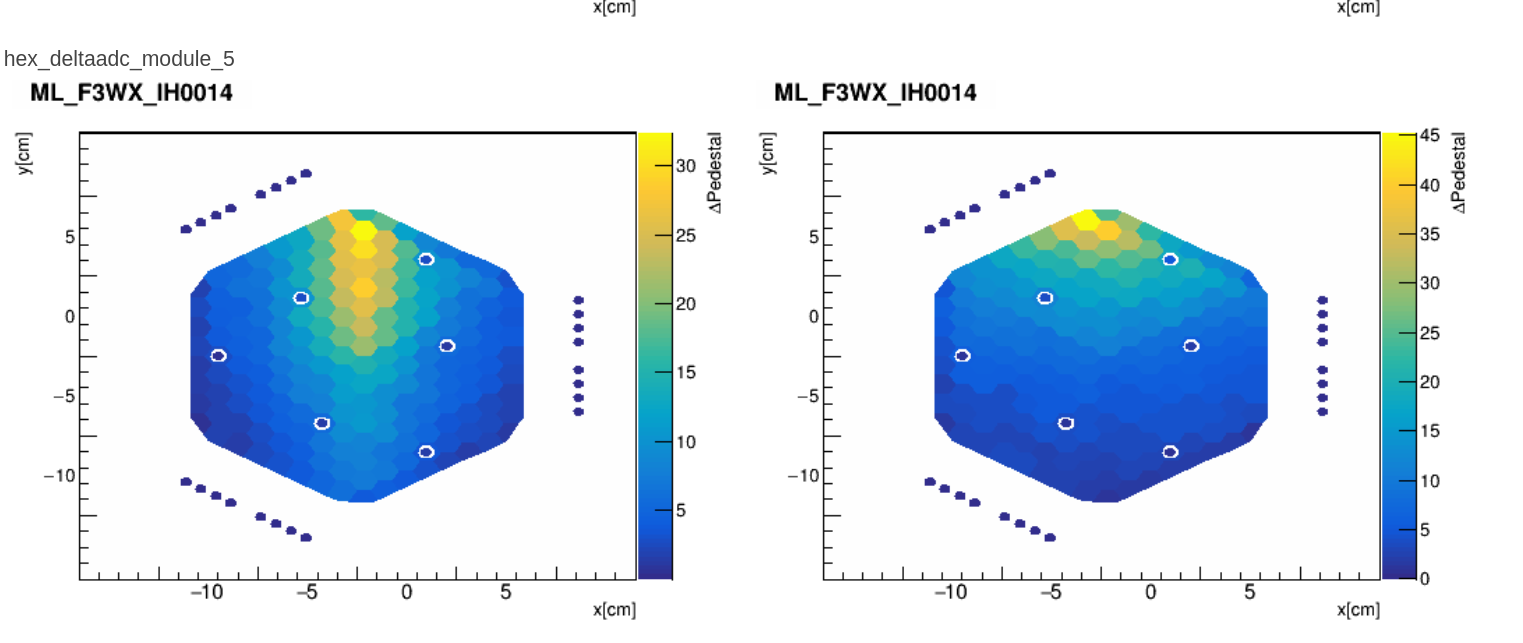
- Thank you to everyone who helped us before/during the beam tests
Main: LHCB ECAL (D. Manuzzi, L. Martinazzoli)
- Installation done yesterday afternoon.
- DESY table not availbale, we moved to the NIKHEF table + XSCA table on concrete block in front
- Safety visit done.
- Data taken during yesterday evening and night
- Know Shashlik calorimeter module used to get reference measurements of the beam energy spread. Analysis ongoing. Everything looks good so far.
- Fine aligment and and not worring debugging of DAQ are ongoing.
- Plan to continue working with pure electron beam (20-100 GeV), plus ancillary measurements with muons and pions (e/πe/π discrimination)

H4:
Main: DRD1 (Yorgos Tsipolitis, Karl Floethner, Katerina Kuznetsova)
Very good Beam.
All setups can operate and take data (currently only one setup faces unstable operation).
Successful data taking during the Magnet shift (from 00:00 to 08:00).
Next Magnet shift planned in upcoming night (from 04:00 to 08:00).
Beam tuning for potential Pion beam was done (Thanks to Nikos).
Crane operation for deinstallation requested for next wednesday at 10:00.
RP vesit has to be checked - MD status unclear (according to schedule there would be again no MD)?
Main: GIF++ (Paolo Martinengo)
ATLAS-RPC-Legacy - 1 detector
ATLAS-MPI (RPC & sMDT) - 2 detectors
CMS-CSC - 2 detectors
CMS-RPC - 3 detectors
EP-DT2 - 1 detector
Ecogas - 1 detector
Smooth data taking
Incoming Main: SND (Week 40) - Gerardo Vasquez:
Beam requested: 10k/spill
- muons 100GeV
- Electroncs [50-250] GeV
- pions: [100-200] GeV.
Infrastructure needed:
- DESY Table
- Concrete blocks: 1 160x80x80 and 1 80x80x80
- Crane on Wed 9 to move W walls (200kg)
Test beam goals: Test of two ECAL, one on each week.
- Setup A: ADV SND setup ECAL-shashlik on DESY table, together with timing detector scintilalting layers. Different positions are needed to understand energy share.
- Setup B: SND@LCH ECAL like, check electron showers on different positions.
Installation to be done by 2pm. Safety visit can be done at 3-4 pm?
Setup A

Setup B
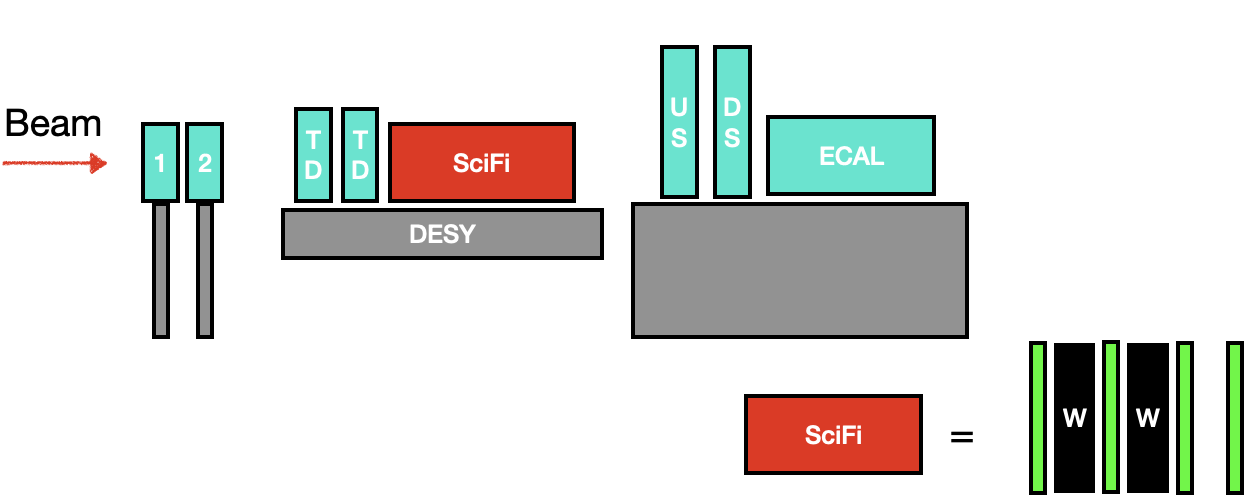
H6:
Outgoing Main: ATLAS HGTD (Stefano Manzoni)
-Succesful two weeks of data-taking
-Thanks to Laurie and the beam team for the help and a very stable beam
-Quick dismounting of the setup in few hours -> we will keep the setup (dismounted) in the area in case of a last week of data taking under discussion with ITK
Outgoing Parallel: PICSEL (Mathieu Goffe)
Successful data taking, everything’s went smoothly Thanks to:
- Very stable beam and good injection cycle
- Laurie (main user) that allow us many short access
- And all the peoples which help us to prepare this beam period and the installation on site
Main: EP PIXEL (Younes Otarid)
Ongoing data taking. Smooth operation so far.
Slightly different ratio of radiation levels to rate compared to previous test-beam periods. To be clarified with Laurie.
Parallel: ATLAS ITK PIXEL (Please Put Your Name Here)
Incoming Main: RADICAL (Week 40) (Alexi Mestvirishvili, James Wetzel, Randy Ruchti)
Set up midday, 2 October with safety inspection in the afternoon.
CERN: Beam pipe extension, Beam Chamber with cabling and power supplies, remotely controlled Motion table,and access to counting room.
Beam: positive (positrons). 10k/spill. Well collimated to avoid beam spray. Energy Range 5 GeV < E < 120 GeV: 5, 10, 25, 50, 75, 100, 125 GeV.
RADiCAL equipment: MCP for timing reference. 1x1 and 2x2 cm^2 trigger scintillators. RADiCAL module. 25 radiation lengths and 1 lambda. Pb glass backing calorimeter. NIM trigger logic. All elements read into CAEN DT5742 waveform digitizers.
Goals: To demonstrate timing resolution at EM Shower Max of ~ 15 psec for a positron beam energy of 125 GeV, and in the high energy limit ~ 10psec. To assess the timing resolution for low energy positrons. Study shower position resolution.
Run plan:
2 October: bring all equipment into functional operation, beam energy at highest value to verify no saturation of low gain SiPM signals.
3 October - 6 October: 1M triggers at each of seven beam energies using DSB1 WLS.
6 October - 8 October: 1M triggers at up to seven beam energies using LuAG:Ce WLS.
9 October - disassembly of equipment, and safety checkout.
Contacts:
On site spokesperson: James Wetzel (jwetzel@coe.edu, +1 563 508 3336)
On site technical coordinator: Alexi Mestvirishvili (alexi.mestvirishvili@cern.ch, 16-2942)
Remote: electrical engineer - Thomas Anderson (tba9h@virginia.edu, +1 434 227 1166)
Remote: Randy Ruchti (rruchti@nd.edu, +1 574 302 7181)
Note: This work is performed in connection with ECFA DRD6-WP3.
H8:
Main: ATLAS TILECAL (Giulio Usai and Tigran Mkrtchyan)
We have the usual setup with two legacy modules and two upgrade modules where we study the calibration and how to propagate this into ATLAS. This Run we have the full off-detector chain with Pre-processor (CPM/ACB/TDAQi), all components going into the FDR in October and FELIX.
We have also the last version of the on-deftector electronics in particular the Daughterboard which pass the FDR in august
During the first week we were able to take beam only on the legacy electronics/detector due
to problems in the readout of the phase-2 upgrade readout chain.
All the problems are finally solved and we started finally with beam on the phase-2 system. We hope to complete the electron program before tomorrow at 10, when we will switch the gas in the cherenkov and start the hadron/muon program program
The beam quality is excellent like last run.
If there are no users downstream, on week 40 we would like to take the possibility to stay in the area and then move in garage on Week 41
Many thanks to all personnel of SPS and NA for their help.
Incoming Main: BI XBPF (Week 40) (Please Put Your Name Here)
Parasitic Users
H6: ATLAS MALTA (Ignacio Asensi (BCM update))
BCM finally left the setup on Friday. We were finally able to take meaninful data. For that thanks to the MALTA people for letting us stay a little longer. MALTA setup is back permanent setup.
H6: ALICE ITS3 (Paolo Martinengo)
set-up installed & commisioned yesterday, started data taking
H8: STRAW TRACKER RD (Please Put Your Name Here)
H8 Outgoing: TRIDENT (Please Put Your Name Here)
AoB
Minutes by the respective speakers, edited by E. B. Holzer, M. Jäkel, T. Shulha, and M. Schwinzerl
















